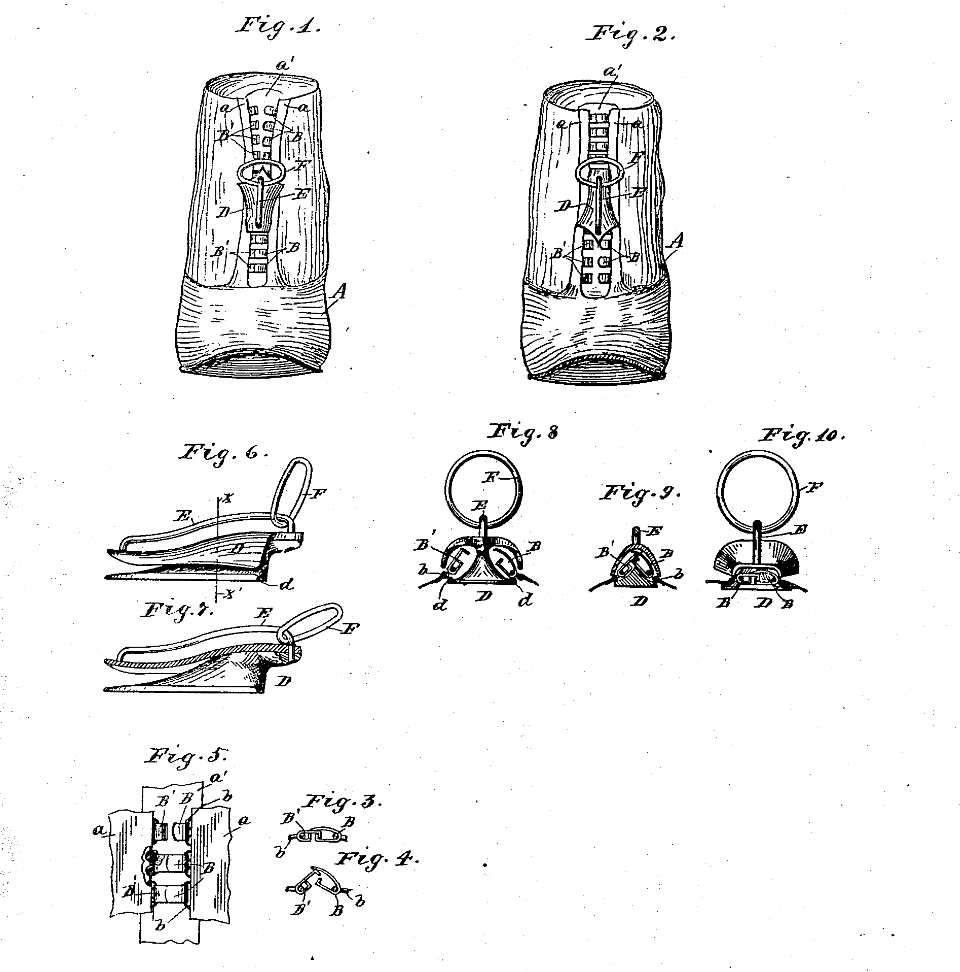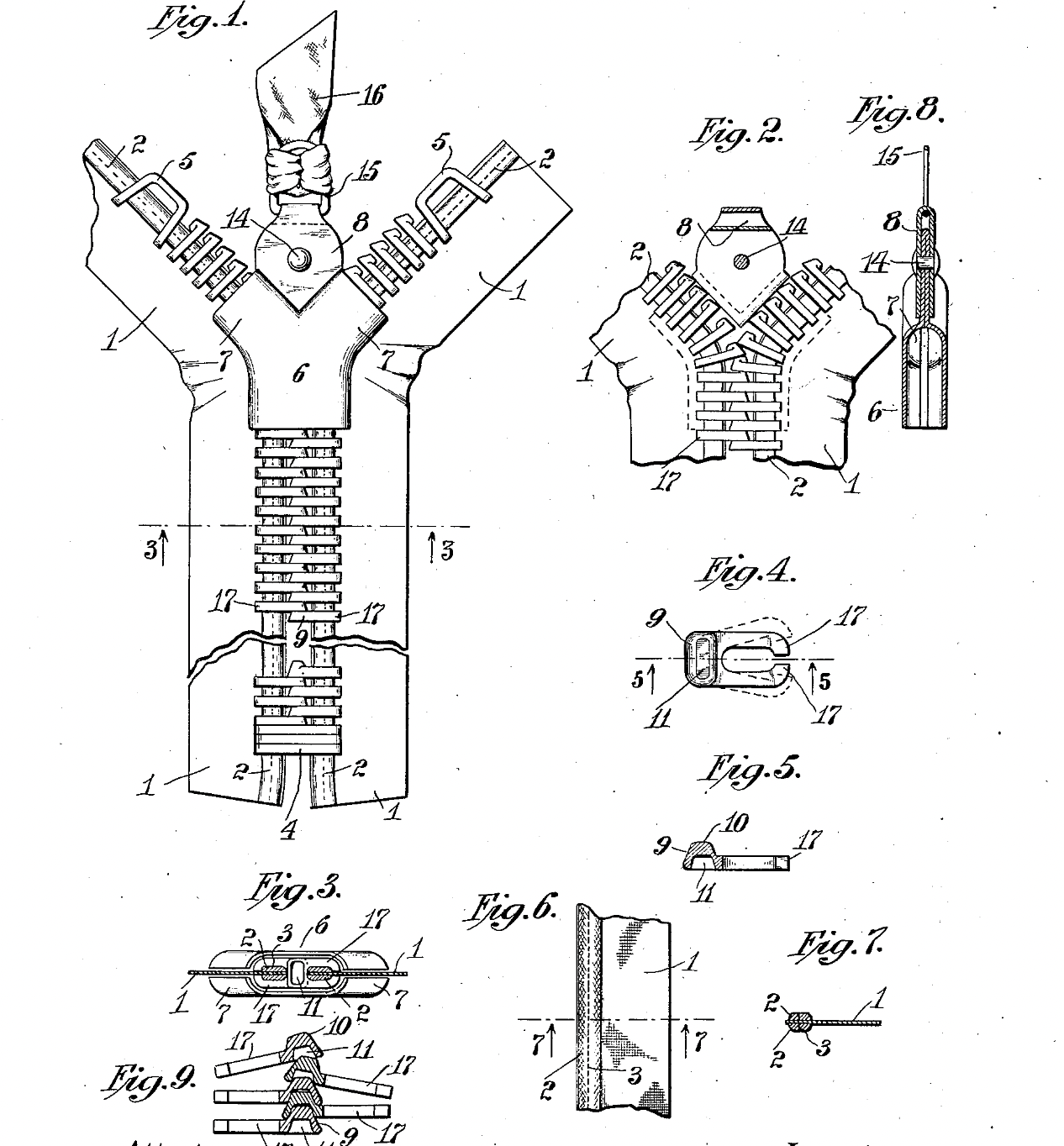Zippers
History
The story begins in 1851 with Elias Howe Jr., the inventor of the sewing machine. He created what he called the Automatic, Continuous Clothing Closure. Individual clasps were joined manually, and pulled shut by using a string, creating a gathering effect.
It didn't go much further beyond that. It’s assumed that the success of the sewing machine caused Elias not to pursue marketing his clothing closure system.
Forty-four years later, inventor Whitcomb Judson marketed a "Clasp Locker" device similar to Elias’s patent. Being the first to advertise, Whitcomb got credit for being the inventor of the zipper, though his 1893 patent did not use the word zipper. He manufactured a hook and eye shoe fastener. It’s said he was trying to help a friend with a bad back fasten his shoes but I’m not sure if that is true or just a nice story for promotional purposes.

A diagram from Judson's Clasp Locker patent.
The innovative aspect of his device was the addition of a slider that closed and opened the fastener. The user would no longer have to fasten each hook individually. This slider was removable and could be used to open or close the fastener by reversing its direction. If you forgot the slider, you were stuck in your shoes.
Modern Zippers
In 1917 Gideon Sundback, a Swedish American electrical engineer, developed a hookless fastener that used interlocking teeth that were easy to fasten and release with an attached slider. The teeth interlocked the way spoons can nest within one another and were closely spaced for security.
Another innovation in this version was that the teeth on both sides were the same; No need for hooks on one side and eyes on the opposite side. It was patented as the Separable Fastener. This invention piqued the interest of the army who began using it in their clothing and equipment but it was still not common in civilian life.

A diagram from Sundback's Separable Fastener patent.
The B.F. Goodrich Company, which used the zipper for rubber boots coined the name “zipper” in 1923 because of the sound it made.

An ad for Goodrich zipper boots.
Boots and tobacco pouches were how most zippers were implemented until the later 1920's and early 1930’s when zippers were promoted for children’s clothing because they made dressing easier and encouraged independence.
Only after the contributions of Howe, Judson, Sundback, and the B.F. Goodrich Company does Tadao Yoshida and YKK get added to the zipper history books. They are the world's largest zipper manufacturer with facilities located in 71 countries. If you take a look at your zipper you will probably find that the pull is stamped with the initials YKK (for Yoshida Kōgyō Kabushiki gaisha, Yoshida Manufacturing Corporation).
Until his death in 1993, Tadao expanded his business globally based on the management philosophy of The Cycle of Goodness, which is the idea that “no one prospers without rendering benefit to others.” Tadao Yoshida firmly believed that business belongs to society. As an important member of society, a company survives through coexistence: when the benefits are shared.
The 1960's saw the rise of lightweight nylon-coil zippers, and eventually the unobtrusive invisible zippers that are standard in much of today’s ready-to-wear clothing.
Fun Facts
Esquire magazine raved in 1937 that the zipper would help men avoid "the possibility of unintentional and embarrassing disarray." Unfortunately, it forgot that what goes up, must come down.
A number of celebrities have been caught with an open fly in public. This list includes:
- Brad Pitt
- Robert Pattinson (on two occasions)
- Robert Downey Jr.
- President George Bush
- British Prime Minister Winston Churchill (who remarked on the event, "It is of no account; after all, the old bird does not fly far from his nest.")
According to a study published in the British Journal of Urology International, zippers are the most common cause of serious genital injury (For those keeping score, bicycles are #2).